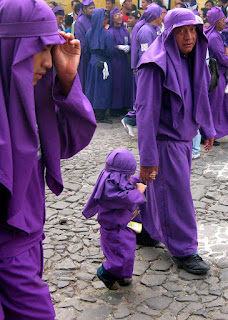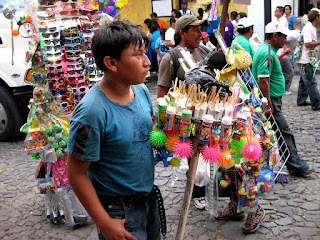Every Sunday during Lent, the processions in Antigua grew larger and larger. By Semana Santa, the processions lasted over 12 hours and employed thousands of purple-robed Guatemalans.
Before the procession passed through the streets, residents would create intricate alfombras, rugs made of died wood chippings, sand, grass, or fruits/vegetables. The rugs, beautiful and time-intensive, are destroyed in seconds as one hundred robed feet pass over.
The processions carried on late into the night, often ending around dawn. One of the most famous processions, La Merced, is depicted below.
The Guatemalan women also play a big part in Semana Santa. Every procession has a women's anda, stand, that is carried by 80 women on each side. The anda is made of long, thick wood and is very heavy. Por eso, the walk is slow and grueling, in tune with the music.
And the music, slow and somber, is one of the most memorable aspects of Semana Santa. Hundred of brass players and percussionists march with the procession, repeating the same somber songs that strike a deep chord with the spectators.
The church, musicians, and spectators aren't the only ones benefitting from Semana Santa. Hundred of local vendors gathered to prey on the big crowds. I may or may not have been subject to sales pressure and caved, of course, buying some sweet shades and a balloon.









No comments:
Post a Comment